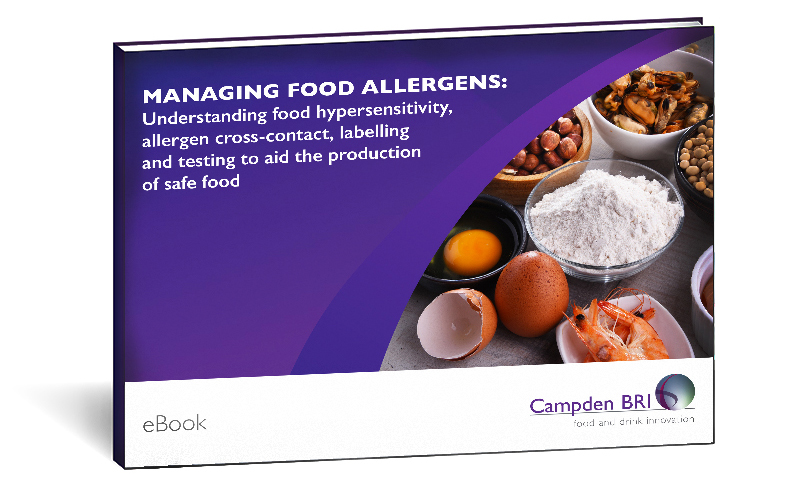
Are you following developments in precautionary allergen labelling and information?
4 July 2023 | Helen Arrowsmith, Regulatory Affairs Manager and Allergen Specialist
In many jurisdictions there is currently no specific legislative requirement to provide information on allergens that are unintentionally present in food or drink due to cross-contact. This blog discusses precautionary allergen labelling/information (often referred to as ‘may contain’ statements) and details recent developments in this area.
Download our FREE Managing Food Allergens eBook today! Secure food safety, control and confidence through effective allergen management

Provision of allergen information
For the estimated 3-10% of adults and 8% of children globally with a food allergy, and many more people with other food hypersensitivities such as food intolerance and coeliac disease, there is currently no widely available cure - the only way to prevent reactions is to avoid the food that triggers symptoms. It is therefore vitally important that food businesses provide consumers with clear and accurate information about the potential or known presence of substances that could cause food hypersensitivity reactions in products, to allow consumers to make informed, safe food choices.
Several countries and regions (including the UK, Europe, America, Canada, Japan, Australia and New Zealand for example) have introduced legislation that requires the presence of major food allergens, and their derivatives, to be labelled when they are included as ingredients in prepacked foods. Such information is also increasingly required for non-prepacked food, such as in catering situations, to be provided to consumers.
Only a few jurisdictions, however, have specific legislative requirements relating to precautionary allergen declarations, i.e. information on the potential of unintended presence of food allergens. Such information is often called ‘precautionary allergen labelling’ (PAL) when it is on the label of prepacked foods or ‘precautionary allergen information’ when referring to non-prepacked foods.
Sources of allergen cross-contact
Ingredients can become contaminated with food allergens in the supply chain, for example during the growing, harvesting, processing and transport of crops. Allergen cross-contact may occur during the production of final products; this can happen when several food products containing or not containing different allergens, are made on the same premises, processing line or equipment.
Food businesses spend a lot of time, effort and money implementing allergen management practices, including controls to prevent or minimise the potential for allergen cross-contact. It should be considered though that very small amounts of food can cause reactions in sensitive people; for example, a drop of milk, a fragment of peanut or just one or two sesame seeds. Therefore, despite the best efforts of the food business, sometimes there remains an unavoidable risk of allergen cross-contact that cannot be sufficiently controlled.
When should precautionary statements be used?
Where food is marketed in a country or region where specific legislation applies regarding PAL, this must be complied with. Guidance from the Food Standards Agency states that in the absence of specific legislative requirements in the UK, precautionary statements regarding possible allergen cross-contact should be justifiable only on the basis of a meaningful risk assessment applied to a responsibly managed operation. Such statements should not be used as a substitute for good hygiene and/or safety practices; they should only be used where there is a demonstrable and significant risk of allergen cross-contact.
What should precautionary statements say?
In jurisdictions where the wording for such statements is regulated, this must be adhered to. In areas where the wording is not specified in law, research has found tens of different statements are being used to communicate to consumers. Most commonly, precautionary allergen labelling of prepacked food is seen to include use of statements such as ‘may contain X’ and ‘not suitable for those with X allergy’; whereas, for non-prepacked food, examples such as ‘produced in a kitchen which uses X’ are often seen. As there is currently no precise wording laid down in UK law, such statements provided on a voluntary basis must not mislead the consumer or be ambiguous or confusing.
Developments to be aware of
There is work being conducted and discussions happening at national and international levels about managing food allergens, the use of allergen threshold levels to inform allergen risk management for foods and standardising the application and wording of PAL. We have listed below some of these works worth being aware of:
- The Food Standards Agency ran a consultation on the provision of precautionary allergen labelling and precautionary allergen information, for many types of food sold in England, Northern Ireland and Wales. The consultation ran from 6 December 2021 to 14 March 2022, the FSA have published a report on findings and summary of stakeholder responses (May 2022). The results of the exercise will be used to determine the next steps in terms of policy. In addition, there is guidance for small food businesses on using precautionary allergen labelling on the FSA website.
- The FSA also ran a consultation from 27 March 2023 to 22 May 2023 to gather opinions on, among other aspects, proposed best practices on PAL; the Summary of stakeholder responses was published in August 2023 and updated Food allergen labelling and information requirements technical guidance was published on 4 September 2023.
- The Codex Alimentarius Commission (Codex), a collaboration between the Agriculture Organization of the United Nations (FAO) and the World
Health Organization (WHO), published in 2020 a
Code of Practice on Food Allergen Management for Food Business Operators .
The Code provides guidance to food business operators, including primary producers, to develop policies and procedures to identify
allergens in all areas of food production, preparation and service, and then implement allergen management practices – also see our blog
on ‘Food allergen management: What you need to know about the Codex code of practice’.
Following on from publication of the COP, an Ad hoc Joint FAO/WHO Expert Consultation on Risk Assessment of Food Allergens was set up
and has published the following reports:
- To review and validate the Codex priority allergen list through risk assessment
- To review and establish threshold levels in foods of the priority allergens
- To review and establish precautionary labelling in foods of the priority allergens
- To review and establish exemption for the food allergens
- To review and establish threshold levels for specific tree nuts (Brazil nut, macadamia nut or Queensland nut, pine nut), soy, celery, lupin, mustard, buckwheat, and oats
- Over the last few years, there has been an increase in interest around the use of quantitative risk assessment (QRA) as a tool to help
decide whether precautionary allergen information is required. It is worth being aware of the work of the following groups in this area:
- The Allergen Bureau (Australia and New Zealand) - Voluntary Incidental Trace Allergen Labelling (VITAL) program
- FoodDrinkEurope - Precautionary Allergen Labelling (PAL): a science-based approach based on Quantitative Risk Assessment (2021), also the publication in March 2022 of version 2 of Guidance on Food Allergen Management for Food Manufacturers .
- International Life Sciences Institute (ILSI) Europe - Food Allergy Task Force have been working in this area for a number of years; please refer to 'Allergen quantitative risk assessment within food operations: Concepts towards development of practical guidance based on an ILSI Europe workshop' (August 2022) and Practical Guidance on the Application of Food Allergen Quantitative Risk Assessment (QRA)' (June 2022)
Food legislation is constantly evolving. For all working in food and drink manufacture, retail and service, navigating the local and global regulatory environment and keeping abreast of regulatory developments is challenging. For over 100 years we have kept the global food and drink industry informed, compliant and prepared for the future. Our Regulatory experts guide our clients through the complexities of food labelling legislation world-wide, navigating the subtle differences between regions, markets and jurisdictions.
For support on precautionary allergen labelling/precautionary allergen information, allergen labelling, or food labelling, get in touch with our Regulatory Affairs team.
How can we help you?
If you’d like to find out more about allergen labelling, contact our support team to find out how we can help.
Managing Food Allergens eBook
Download our FREE Managing Food Allergens eBook today! Secure food safety, control and confidence through effective allergen management.







